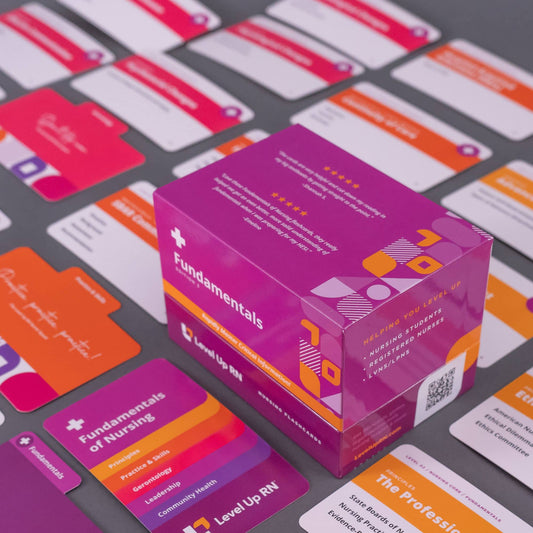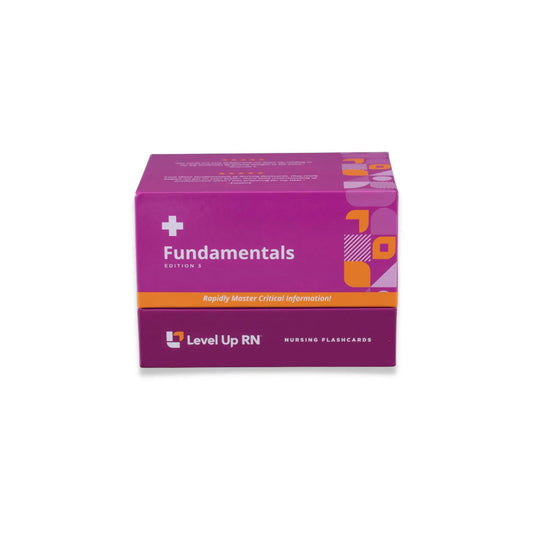Fundamentals - Community Health, part 7: Community Health Plan and Assessments
Updated: Ellis ParkerThe nursing process steps as they relate to developing a community health plan, including specific data collection methods used in the assessment of a community like informal interviews, direct observation, windshield surveys, secondary analysis, and surveys.
Full Transcript: Fundamentals - Community Health, part 7: Community Health Plan and Assessments
Full Transcript: Fundamentals - Community Health, part 7: Community Health Plan and Assessments
Hi, I'm Ellis with Level Up RN. In this video, we'll be chatting about the community health plan and a community assessment. These cards can be found in the community section of our fundamentals of nursing flashcard deck. So if you have that deck, grab these cards, and you can follow along with me. If you don't have the deck, I encourage you to check us out at leveluprn.com. After the content, hang tight because I will have a couple of questions just to check your knowledge. A community health plan is simply a patient care plan but for the whole community. And thus, it follows the nursing process, which is our ADPIE model. Assessment, diagnosis, planning, intervention, and evaluation. And this pretty much follows what you would do for a regular patient care plan. I think the key difference here is the assessment part. For an assessment step of a community health care plan, first, you actually have to choose the aggregate on which you want to do the assessment. So identifying the aggregate that you want to study and performing data collection on that aggregate. So this is going to be a much more, I don't know, involved or intense or heightened version of an assessment because instead of assessing one person, you're assessing a group of them. So by doing this, you'll identify what the community needs might be, what problems they're facing, what strengths they have as a collective, and then you can base that community health plan off of what you've assessed.
So our next step would, of course, be diagnosis. So analyzing and prioritizing the community health problem that you are identifying and that that aggregate is experiencing. The planning, implementation, and evaluation steps are all pretty much the same in that you would plan specific and measurable goals to address the problem that you identified and then plan interventions to meet those goals. Implementation is to then carry out the plan and provide the implementations that you've developed. And evaluation is simply assessing the effectiveness of the implemented steps that you are able or whomever was able to provide, understanding what factors contributed to success or not being successful of the original goals.
As I just mentioned, the assessment step of the nursing process when doing a community health plan is what is unique when compared to doing a regular patient care plan because we're going to have to do unique types of assessments to get that information on the aggregate. So one type of assessment that we can do is informant interviews. And this is exactly what it sounds like. It is collecting data by performing interviews with individuals in the targeted community. There's also direct observation, which again is exactly what it sounds like. It is observing individuals in a community at a specific place or location over a period of time. A windshield survey is particularly popular to ask students to do when they're in a community health class. And that, again, is pretty much what it sounds like. It's driving around in the community and observing what you can observe through your car's windshield. So what kind of people live in this community? Where do they live? What kind of housing is available? What stores or businesses or food options are there? How many schools are there? What kinds of schools are there? Are there parks or green spaces or open spaces? What is the accessibility to healthcare and what type of healthcare options are available?
A secondary analysis is analyzing data that is preexisting, so data that somebody else has already collected and some of this is publicly accessible. So the Census Bureau data, vital statistics records, community health records, anything that someone else has already collected would be a secondary analysis. And the final example that we have is surveys. And again, this is pretty straightforward. This would be providing and collecting surveys from individuals in the targeted community. That wraps up the content for this video, so hang tight. Let's cover a couple of questions to check your knowledge. Describe a windshield survey. A windshield survey is observations about a given area as perceived through a car window. What are the examples I gave you of data that you could review during a secondary analysis? Remember a secondary analysis is reviewing preexisting data, and the examples I gave you are vital statistics records, community health records, and census data. Thank you so much for studying with me. In our next video, we'll be diving into epidemiology.


